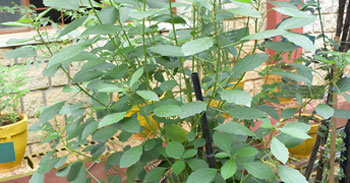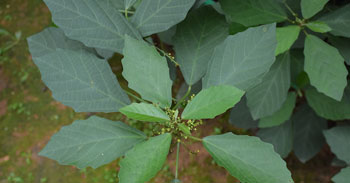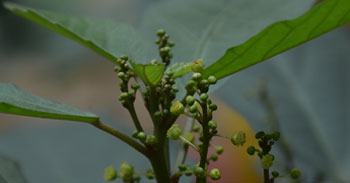KJC Medicinal Garden
Kadu haralu
Baliospermum montanum
Order: Malpighiales
Family: Euphorbiaceae
Genus: Baliospermum
Species: B. Montanum
Common Names: Hastidanti, Red physic nut, Wild castor, Wild croton, Wild sultan seed
Native to Southeast Asia and the Himalayas
Other plants of the same genus with medicinal properties
-
B. angustifolium
B. bilobatum
B. calycinum
B. yui
B. analayanum
B. malayanum
B. reidioides
- Perennial stout undershrub (3.5 m tall), Woody base, herbaceous branches from roots
- Leaves: Simple, sinuate, toothed, varies in shape and size (upper one: long petioled, lower one: long orate)
- Stems are anti-dontalgic.
- Flowers: Unisexual, numerous, arranged in axillary racemes
- Fruits: Capsules, long, obovoid.
- Seeds: Ellipsoid, smooth, mottled.
Uses in Tradition systems of medicine
- Used in Ayurveda and Unani
- Roots, leaves and seeds are used for the treatment of constipation, abdominal pain, dropsy, anascara, jaundice, asthma, calculus, hemorrhoids, helmenthic infections, scabies, dermic infections, supparative ulcers and diseases.
- Served as decoction, Used as poultice, purgative, stimulant and rubefacient externally
- Finds mention in Charakasamhita (Ayurvedic text)
- Word Danti means “the snaketooth”
- Carbohydrates, proteins, alkaloids, steroids, glycosides, coumarin, fatty acids and amino acids.
- Saponins, tannins, anthroquinones, terpenoids and phenols.
- Glycoterpenoids, titerpenoids, diterpenes.
Suggested Medicinal Properties
- Purgative
- Thermogenic
- Diuretic
- Anthelmintic
- Hydroxynitrile Lyase (HNL) Activity
- Laxative
- Immunomodulatory activity
- Blood purifier
Active Phytochemicals
1. Montanin (C32H48O8; yield, 0.018%)
2. baliospermin (0.003%)
3. 12-deoxyphorbol-13-palmitate (0.021%)
4. 12-deoxy- 16-hydroxyphorbol-13-palmitate (0.001 %)
5. 12-deoxy- 5β-hydroxyphorbol-13-myristate (0.007%)
6. Alkaloids (6.2-9.5%)
7. Flavonoids (35.63-43.33%)
8. Saponins (9.9 to 13.2%)
9. Phenolics (38.43 to 43.44%)
10. Tannins (13.26 to 18.3%)
11. Terpenoids (25.36 to 33.4%)
References
Mali, R. and Wadekar, R., 2008. Baliospermum montanum (Danti): Ethnobotany, phytochemistry and pharmacology- A review. International Journal of Green Pharmacy (Int J Green Pharm)


